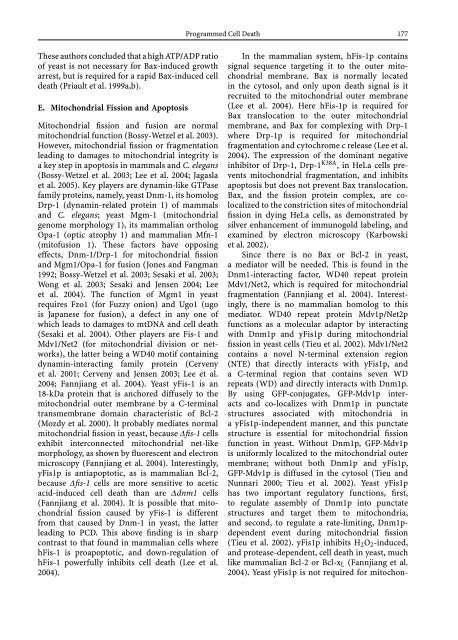Growth, Differentiation and Sexuality
Growth, Differentiation and Sexuality
Growth, Differentiation and Sexuality
Create successful ePaper yourself
Turn your PDF publications into a flip-book with our unique Google optimized e-Paper software.
These authors concluded that a high ATP/ADP ratio<br />
of yeast is not necessary for Bax-induced growth<br />
arrest, but is required for a rapid Bax-induced cell<br />
death (Priault et al. 1999a,b).<br />
E. Mitochondrial Fission <strong>and</strong> Apoptosis<br />
Mitochondrial fission <strong>and</strong> fusion are normal<br />
mitochondrial function (Bossy-Wetzel et al. 2003).<br />
However, mitochondrial fission or fragmentation<br />
leading to damages to mitochondrial integrity is<br />
a key step in apoptosis in mammals <strong>and</strong> C. elegans<br />
(Bossy-Wetzel et al. 2003; Lee et al. 2004; Jagasla<br />
et al. 2005). Key players are dynamin-like GTPase<br />
family proteins, namely, yeast Dnm-1, its homolog<br />
Drp-1 (dynamin-related protein 1) of mammals<br />
<strong>and</strong> C. elegans; yeast Mgm-1 (mitochondrial<br />
genome morphology 1), its mammalian ortholog<br />
Opa-1 (optic atrophy 1) <strong>and</strong> mammalian Mfn-1<br />
(mitofusion 1). These factors have opposing<br />
effects, Dnm-1/Drp-1 for mitochondrial fission<br />
<strong>and</strong> Mgm1/Opa-1 for fusion (Jones <strong>and</strong> Fangman<br />
1992; Bossy-Wetzel et al. 2003; Sesaki et al. 2003;<br />
Wong et al. 2003; Sesaki <strong>and</strong> Jensen 2004; Lee<br />
et al. 2004). The function of Mgm1 in yeast<br />
requires Fzo1 (for Fuzzy onion) <strong>and</strong> Ugo1 (ugo<br />
is Japanese for fusion), a defect in any one of<br />
which leads to damages to mtDNA <strong>and</strong> cell death<br />
(Sesaki et al. 2004). Other players are Fis-1 <strong>and</strong><br />
Mdv1/Net2 (for mitochondrial division or networks),<br />
the latter being a WD40 motif containing<br />
dynamin-interacting family protein (Cerveny<br />
et al. 2001; Cerveny <strong>and</strong> Jensen 2003; Lee et al.<br />
2004; Fannjiang et al. 2004). Yeast yFis-1 is an<br />
18-kDa protein that is anchored diffusely to the<br />
mitochondrial outer membrane by a C-terminal<br />
transmembrane domain characteristic of Bcl-2<br />
(Mozdy et al. 2000). It probably mediates normal<br />
mitochondrial fission in yeast, because Δfis-1 cells<br />
exhibit interconnected mitochondrial net-like<br />
morphology, as shown by fluorescent <strong>and</strong> electron<br />
microscopy (Fannjiang et al. 2004). Interestingly,<br />
yFis1p is antiapoptotic, as is mammalian Bcl-2,<br />
because Δfis-1 cells are more sensitive to acetic<br />
acid-induced cell death than are Δdnm1 cells<br />
(Fannjiang et al. 2004). It is possible that mitochondrial<br />
fission caused by yFis-1 is different<br />
from that caused by Dnm-1 in yeast, the latter<br />
leading to PCD. This above finding is in sharp<br />
contrast to that found in mammalian cells where<br />
hFis-1 is proapoptotic, <strong>and</strong> down-regulation of<br />
hFis-1 powerfully inhibits cell death (Lee et al.<br />
2004).<br />
Programmed Cell Death 177<br />
In the mammalian system, hFis-1p contains<br />
signal sequence targeting it to the outer mitochondrial<br />
membrane. Bax is normally located<br />
in the cytosol, <strong>and</strong> only upon death signal is it<br />
recruited to the mitochondrial outer membrane<br />
(Lee et al. 2004). Here hFis-1p is required for<br />
Bax translocation to the outer mitochondrial<br />
membrane, <strong>and</strong> Bax for complexing with Drp-1<br />
where Drp-1p is required for mitochondrial<br />
fragmentation <strong>and</strong> cytochrome c release (Lee et al.<br />
2004). The expression of the dominant negative<br />
inhibitor of Drp-1, Drp-1 K38A , in HeLa cells prevents<br />
mitochondrial fragmentation, <strong>and</strong> inhibits<br />
apoptosis but does not prevent Bax translocation.<br />
Bax, <strong>and</strong> the fission protein complex, are colocalized<br />
to the constriction sites of mitochondrial<br />
fission in dying HeLa cells, as demonstrated by<br />
silver enhancement of immunogold labeling, <strong>and</strong><br />
examined by electron microscopy (Karbowski<br />
et al. 2002).<br />
Since there is no Bax or Bcl-2 in yeast,<br />
a mediator will be needed. This is found in the<br />
Dnm1-interacting factor, WD40 repeat protein<br />
Mdv1/Net2, which is required for mitochondrial<br />
fragmentation (Fannjiang et al. 2004). Interestingly,<br />
there is no mammalian homolog to this<br />
mediator. WD40 repeat protein Mdv1p/Net2p<br />
functions as a molecular adaptor by interacting<br />
with Dnm1p <strong>and</strong> yFis1p during mitochondrial<br />
fission in yeast cells (Tieu et al. 2002). Mdv1/Net2<br />
contains a novel N-terminal extension region<br />
(NTE) that directly interacts with yFis1p, <strong>and</strong><br />
a C-terminal region that contains seven WD<br />
repeats (WD) <strong>and</strong> directly interacts with Dnm1p.<br />
By using GFP-conjugates, GFP-Mdv1p interacts<br />
<strong>and</strong> co-localizes with Dnm1p in punctate<br />
structures associated with mitochondria in<br />
a yFis1p-independent manner, <strong>and</strong> this punctate<br />
structure is essential for mitochondrial fission<br />
function in yeast. Without Dnm1p, GFP-Mdv1p<br />
is uniformly localized to the mitochondrial outer<br />
membrane; without both Dnm1p <strong>and</strong> yFis1p,<br />
GFP-Mdv1p is diffused in the cytosol (Tieu <strong>and</strong><br />
Nunnari 2000; Tieu et al. 2002). Yeast yFis1p<br />
has two important regulatory functions, first,<br />
to regulate assembly of Dnm1p into punctate<br />
structures <strong>and</strong> target them to mitochondria,<br />
<strong>and</strong> second, to regulate a rate-limiting, Dnm1pdependent<br />
event during mitochondrial fission<br />
(Tieu et al. 2002). yFis1p inhibits H2O2-induced,<br />
<strong>and</strong> protease-dependent, cell death in yeast, much<br />
like mammalian Bcl-2 or Bcl-xL (Fannjiang et al.<br />
2004). Yeast yFis1p is not required for mitochon-

















